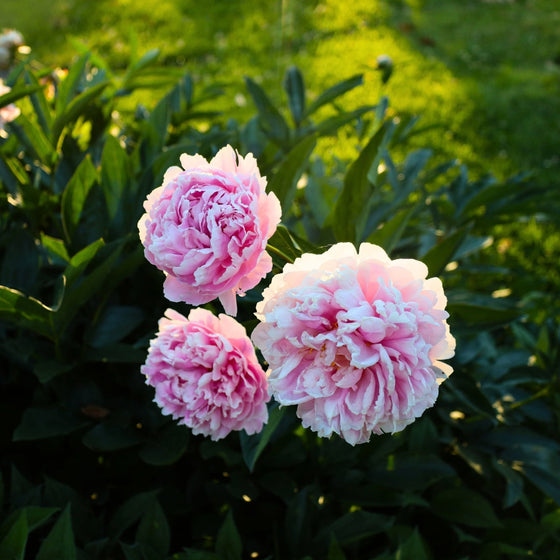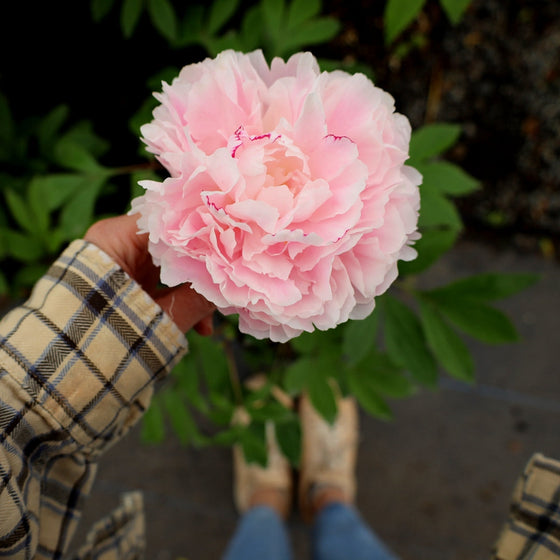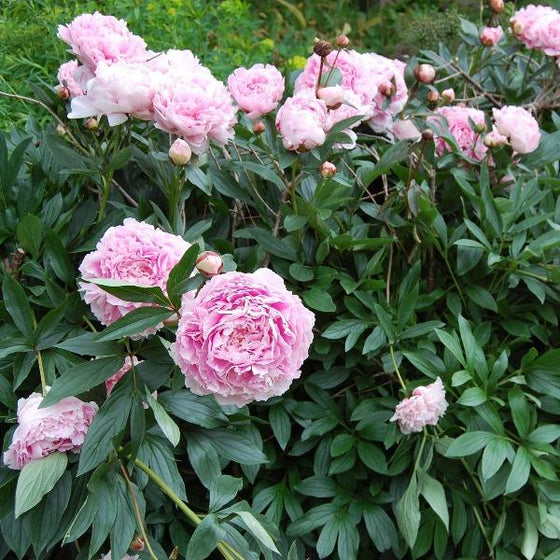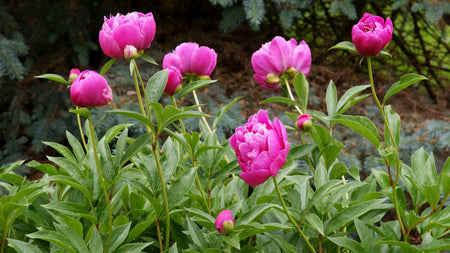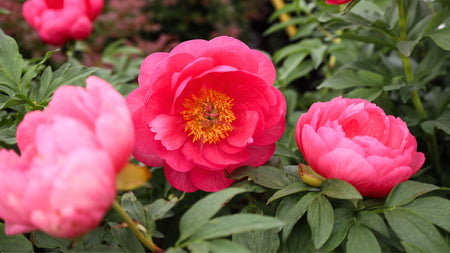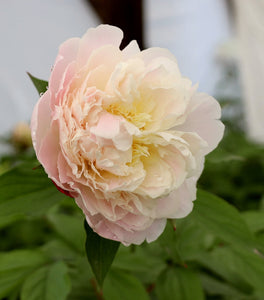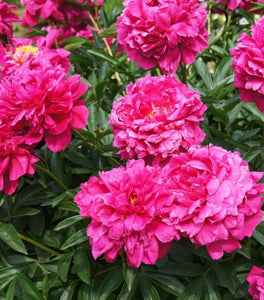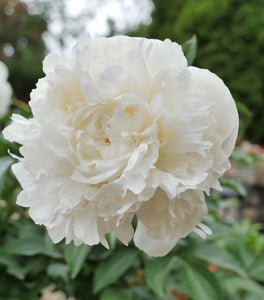
Images Depict Mature Plants
Sarah Bernhardt Peony Plants
Sarah Bernhardt Peony (Paeonia lactiflora 'Sarah Bernhardt') is a timeless garden favorite known for its luxurious, double pink blooms and delightful fragrance. Blooming in late spring to early summer, this classic herbaceous peony showcases ruffled petals in shades of soft blush pink, often accented with creamy highlights and deeper rose tones at the center. Each large, globe-shaped flower can reach up to 8 inches across, making it a show-stopping focal point in cut flower arrangements, cottage gardens, and formal perennial borders.
Growing to a mature height of 2.5 to 3 feet, Sarah Bernhardt Peony forms a lush, rounded clump of deep green foliage that remains attractive even after flowering. It thrives in full sun to part shade and prefers rich, well-drained soil. Once established, this hardy perennial is low maintenance, deer resistant, and long-lived, often blooming for decades with minimal care. For best results, plant peonies in a location where they can remain undisturbed for many years, as they do not like to be frequently moved.
Perfect for foundation plantings, mixed borders, and cutting gardens, the Sarah Bernhardt Peony adds a touch of romantic charm and elegance to any landscape. Its heavily fragrant blooms attract pollinators and bring sweet scent and beauty indoors when cut for floral displays. With its exceptional flower form, reliable performance, and time-honored appeal, this peony remains one of the most cherished varieties for both gardeners and florists alike.
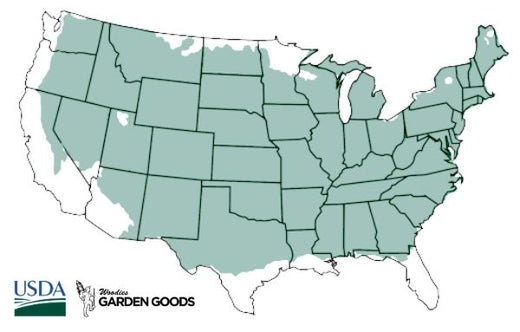
| Hardiness Zone: | 4-8 |
|---|---|
| Mature Height: | 30 to 36 Inches |
| Mature Width: | 30 to 36 Inches |
| Sunlight: | Full sun |
| Water Requirements: | Water well until established |
| Flower Color: | Pink double form |
| Bloom Season: | May |
| Details: | Double Pink flowers, fragrant, good cut flower, attracts butterflies |
How to Care for Sarah Bernhardt Peony
Before you buy a Sarah Bernhardt Peony Plants, make sure to read about the care instructions that are recommended to keep this plant healthy and thriving.
How Do I Plant My Sarah Bernhardt Peony Plants?
Planting potted Sarah Bernhardt Peony plants is a simple and rewarding process that sets the stage for years of stunning, fragrant blooms. Begin by selecting a site that offers full sun to light afternoon shade and features well-drained, fertile soil—peonies dislike wet feet and will not thrive in soggy conditions. Dig a hole twice as wide as the pot and about the same depth. Gently remove the peony from its container, loosen the roots if they are pot-bound, and place it in the hole so that the crown (where the stems meet the roots) is no more than 1 to 2 inches below the soil surface. Backfill the hole with a mix of native soil and compost or aged manure to enrich the planting site, then water thoroughly to settle the soil and eliminate air pockets. Space plants 2.5 to 3 feet apart to ensure good air circulation, which helps prevent disease. Apply a thin layer of mulch to conserve moisture and suppress weeds, keeping it a few inches away from the base of the plant. With proper placement and care, your Sarah Bernhardt Peony will flourish, bringing romantic pink blooms and luxurious fragrance to perennial borders, cottage gardens, and cutting beds for decades to come.
How Do I water My Sarah Bernhardt Peony Plants?
Watering your Sarah Bernhardt Peony plants correctly is essential for strong root development and prolific blooms. During the first growing season, keep the soil consistently moist by watering deeply once or twice per week, depending on rainfall and soil type. Focus on watering at the base of the plant to prevent wetting the foliage, which can lead to mildew or fungal issues. Avoid shallow, frequent watering, which encourages weak surface roots. Instead, aim for deep soakings that moisten the root zone, especially during hot, dry spells or prolonged drought. Once established, Sarah Bernhardt Peonies are relatively drought-tolerant, but they will perform best with regular watering during their active growing and blooming period in spring and early summer. Reduce watering after flowering and as the plant enters dormancy in the fall. In poorly drained soils, take care not to overwater, as peonies are susceptible to root rot. By providing consistent, deep watering in well-draining soil, you'll encourage vigorous growth, lush foliage, and spectacular, fragrant pink blooms year after year.
How Do I Fertilize My Sarah Bernhardt Peony Plants?
Fertilizing your potted Sarah Bernhardt Peony plants is essential for promoting healthy growth, lush foliage, and abundant blooms. In early spring, just as new shoots begin to emerge, apply a balanced slow-release fertilizer, such as a 10-10-10 or 5-10-5 blend, around the outer edge of the container. Be sure not to apply fertilizer directly against the crown or stems, as this may cause burn or rot. Water thoroughly after feeding to help the nutrients absorb into the soil and reach the roots. Because potted peonies have limited access to soil nutrients, they may benefit from a second light application of fertilizer in mid-summer, after blooming has finished. Alternatively, use a liquid fertilizer every 4–6 weeks during the growing season, but stop feeding by late summer to allow the plant to begin entering dormancy. Avoid high-nitrogen fertilizers, which encourage leafy growth at the expense of blooms. With the right fertilization routine, your Sarah Bernhardt Peony in containers will thrive and continue to reward you with fragrant, showy pink flowers year after year.

How and When Should I Prune My Sarah Bernhardt Peony Plants?
Pruning Sarah Bernhardt Peony plants is essential for maintaining plant health, encouraging strong flowering, and keeping your garden tidy. During the blooming season, deadhead spent flowers by cutting the flower stem down to a set of healthy leaves—this prevents energy from going into seed production and promotes stronger root and foliage growth. Deadheading also keeps your garden borders and flower beds looking fresh. Be sure to use clean, sharp pruners to make clean cuts and reduce the risk of disease. At the end of the growing season—typically in late fall after the first frost—cut the peony stems down to 1 to 2 inches above ground level once the foliage has turned yellow or brown. Removing the dead foliage helps prevent the overwintering of fungal diseases such as botrytis blight. Dispose of the cuttings rather than composting them to avoid spreading pathogens. Regular seasonal pruning ensures your Sarah Bernhardt Peonies return stronger each spring, producing their signature fragrant pink blooms and maintaining their status as a low-maintenance, long-lived garden favorite.

